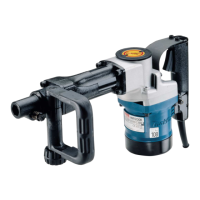6
Service
23. Have your power tool serviced by a qualified
repair person using only identical replacement
parts. This will ensure that the safety of the power
tool is maintained.
24. Follow instruction for lubricating and changing
accessories.
25. Keep handles dry, clean and free from oil and
grease.
SPECIFIC SAFETY RULES
GEB004-2
DO NOT let comfort or familiarity with product
(gained from repeated use) replace strict adherence
to hammer safety rules. If you use this tool unsafely
or incorrectly, you can suffer serious personal injury.
1. Wear ear protectors. Exposure to noise can cause
hearing loss.
2. Use auxiliary handles supplied with the tool.
Loss of control can cause personal injury.
3. Hold tools by insulated gripping surfaces when
performing an operation where the cutting tool
may contact hidden wiring or its own cord. Con-
tact with a “live” wire will make exposed metal parts
of the tool “live” and shock the operator.
4. Wear a hard hat (safety helmet), safety glasses
and/or face shield. Ordinary eye or sun glasses
are NOT safety glasses. It is also highly recom-
mended that you wear a dust mask and thickly
padded gloves.
5. Be sure the bit is secured in place before opera-
tion.
6. Under normal operation, the tool is designed to
produce vibration. The screws can come loose
easily, causing a breakdown or accident. Check
tightness of screws carefully before operation.
7. In cold weather or when the tool has not been
used for a long time, let the tool warm up for a
while by operating it under no load. This will
loosen up the lubrication. Without proper warm-
up, hammering operation is difficult.
8. Always be sure you have a firm footing.
Be sure no one is below when using the tool in
high locations.
9. Hold the tool firmly with both hands.
10. Keep hands away from moving parts.
11. Do not leave the tool running. Operate the tool
only when hand-held.
12. Do not point the tool at any one in the area when
operating. The bit could fly out and injure some-
one seriously.
13. Do not touch the bit or parts close to the bit
immediately after operation; they may be
extremely hot and could burn your skin.
14. Do not operate the tool at no-load unnecessarily.
15. Some material contains chemicals which may be
toxic. Take caution to prevent dust inhalation
and skin contact. Follow material supplier safety
data.
SAVE THESE INSTRUCTIONS.
WARNING:
MISUSE or failure to follow the safety rules stated in
this instruction manual may cause serious personal
injury.
OPERATING INSTRUCTIONS
Installing or removing bull point or other bits
(cold chisel, etc.)
Important:
Always be sure that the tool is switched off and
unplugged before installing or removing the bit.
For HM1200 (Fig. 1)
Pivot the tool retainer to the side. (If it is difficult to move
the tool retainer with your thumbs, tap it with a hammer.)
Insert the bit into the tool barrel as far as it will go. Return
the tool retainer to its original position to secure the bit.
To r emove the b it , fol l ow the i n st all a t io n pr oce d ur e in
reverse.
For HM1200B & HM1200K (Fig. 2)
Pull out and turn the tool retainer 180 degrees (1/2 turn).
Then insert the bit into the tool holder with the notched
portion on the bit facing back toward the tool retainer.
Then pull out and turn back the tool retainer 180 degrees
to secure the bit. Try to pull the bit out of the tool holder to
make sure the retained bit before use.
CAUTION:
Never use B-type shank bits. They can cause damage to
the tool. (For HM1200B)
Side grip/Side handle (auxiliary handle)
For HM1200 (Standard type) (Fig. 3)
The side grip swings around to either side, allowing easy
handling of the tool in any position. Loosen the side grip
by turning it counterclockwise, swing it to the desired
position and then tighten it by turning clockwise.
For HM1200 (European type), HM1200B & HM1200K
(Fig. 4)
The side handle swings around 360° on the vertical as
well as back and forth on the horizontal. Turn the clamp
nut clockwise to secure the handle in the desired position.
Switch action (Fig. 5)
CAUTION:
• Before plugging in the tool, always check to see that
the switch trigger actuates properly and returns to the
“OFF” position when released.
• Do not tape, tie or otherwise secure the trigger in the
“ON” position.
To s ta r t the t o o l, si m p ly pu ll the tr igg e r. Rele as e th e tr i g-
ger to stop.
Chipping / Scaling / Demolition
Hold the tool firmly with both hands. Turn the tool on and
apply slight pressure on the tool so that the tool will not
bounce around, uncontrolled. Pressing very hard on the
tool will not increase the efficiency.

